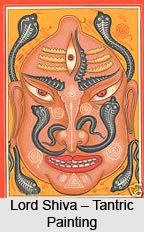 Tantra Paintings are a study of the analogy between the physical body and the universe. The philosophy behind these paintings is same as that of the Tantric philosophy meditation and disciplined bodily behaviour can equip with the power to control the outer world. Tantra tradition is an integral part of Hinduism and it includes usage of mantra. Tantra paintings are quite unique in the sense that the theme and images are very contrasting in nature. The tantric paintings are abstract and are normally very complex. Tantra paintings are known to be obscure. Paintings are gloomy as they have meditations in them.
Tantra Paintings are a study of the analogy between the physical body and the universe. The philosophy behind these paintings is same as that of the Tantric philosophy meditation and disciplined bodily behaviour can equip with the power to control the outer world. Tantra tradition is an integral part of Hinduism and it includes usage of mantra. Tantra paintings are quite unique in the sense that the theme and images are very contrasting in nature. The tantric paintings are abstract and are normally very complex. Tantra paintings are known to be obscure. Paintings are gloomy as they have meditations in them.
Tantra is an esoteric pagan tradition in Hinduism, which includes extensive use of the mantra or symbolic speech and Mandala, symbolic diagrams, to attain enlightenment. The mother goddess is of vital importance in the tradition of Tantra. Hindu Tantric rituals include things like meditation on cremation grounds and corpses, ritualistic use of wine, meat and sexual intercourse. These worldly means will help in unifying the soul with the supreme power. Tantra art exists in Hindu, Buddhist and Jain forms.

Tantric paintings abound in abstract, multivalent and oblique images. The obscurity of these paintings can be attributed on them being meditations on paintings. When a Tantra painting is worshipped it becomes the symbolic representation of the deity and it abounds in energy. Every such painting is the dwelling place of the deity who is being represented. The best part about Tantra art paintings is the spiritual aura surrounding them. It is not just a form of art. It is a form of meditation and manifestation of supreme power. While doing a painting centred on Tantrism it is accompanied by meditation and chanting as it helps to invoke the divine being. This is called "Pranaprathistha" which helps the paintings in getting energy. The colours used in these paintings are red, black, green and gold. Mandala is one of the interesting aspects of Tantric paintings. A spiritual quality is a major characteristic of these paintings. A Tantric painting represent the world and the cosmos as a whole.
Models of Tantric Painting
There are some manuscripts which contain Tantric paintings. Such paintings are visible on paper and cloth too. The Arya-Manjusri-mulkalpa contains a section on Picture-drawing. The Bengali artists, known as Patuas pursue the art-tradition of portraying Tantrism in their works. Painting which prevailed in Eastern India during the Pala rule shows Tantric influence. For example the picture of Loka Natha which dates back to the 12th-13 century. It is in the posture of Ardhaparyahka. The right hand is in the pose of giving a boon and the left hand holds a lotus with the stalk. In some manuscripts figures of deities in accordance with Vajrayana-Tantrayana have been painted that dates back to the 1lth -12th century. These prove that Tantra was an inspiration in the domain of painting. The votaries of Tantra cultivated the art of painting is shown by the paintings in some Tantric manuscripts or wooden covers which belongs to the medieval period.









